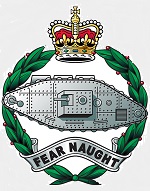Panzerkampf PZK12401 British Mark IV Female Heavy Tank (1:100 Scale)
"Through Mud And Blood To The Green Fields Beyond."
- British Tank Corps Motto in World War I
 The "Female" tank was a type of armoured fighting vehicle deployed during the First World War that carried multiple machine guns, instead of the mix of machine guns and cannons mounted by the original Mark I tank.
The "Female" tank was a type of armoured fighting vehicle deployed during the First World War that carried multiple machine guns, instead of the mix of machine guns and cannons mounted by the original Mark I tank.
The prototype, nicknamed "Mother", and the first production models of what would become referred to as the Mark I were designed to carry two six-pounder guns and three machine-guns. Lieutenant-Colonel Ernest Swinton expressed the fear that tanks armed in such a way might be unable to protect themselves from attacks by large numbers of enemy infantry. In April 1916, it was therefore decided that half of the 150 tanks on order should be fitted with machine guns in place of the six-pounders. A new sponson was designed so that the tank could carry two Vickers machine guns, with their cooling jackets protected by armoured sleeves, on each side of the hull. Swinton's idea was that tanks should operate in pairs: a "destroyer" and a "consort" or "man-killing" tank, providing mutual protection. He stated that he then assigned the names "male" and "female" respectively. The designation "male" applied to those armed with six-pounder guns, whereas the "female" was the tank equipped only with machine guns.
A consequence of these designations was that the prototype Mother became a "male" tank.
The design of the female sponson allowed only a very small door, which made escape from the vehicle extremely difficult. From the Mark II onwards, a new design was introduced that was smaller, incorporated Lewis or Hotchkiss guns, and allowed for much larger doors.
Both male and female tanks took part in the first tank action, on September 15th, 1916, at the Battle of Flers-Courcelette.
In 1918 it was decided that tanks should be 'hermaphrodites', simultaneously male and female, carrying both heavy armament and lighter machine guns. For the WWI tanks, this was achieved by fitting them with one sponson of each type. A mixed ability armament of the heavy gun and multiple machine guns also became common practice on turreted designs, without sponsons. This has become the standard model for tank designs since World War I and since then the terms "male" and "female" have been disused.
The basic idea underlying the concept of female tanks was widely used in design of light tanks and the first British infantry tanks in the years leading to World War II. Some armour of the WWII period, such as the German Ferdinand tank destroyer, were exclusively 'male', having only their heavy gun. These were found to be susceptible to infantry attack and so a defensive MG was added in the improved version, the Elefant
Pictured here is a 1:100 scale replica of a British Mark IV "Female" tank.
Now in stock!
Dimensions:
Length: 2-1/2-inches
Width: 1-inches
Release Date: November 2020


